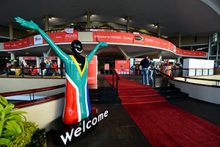 Africa’s Travel Indaba officially opened today with a call for the continent to work collaboratively to drive tourism growth, so as to accelerate the sector’s recovery. Held at the Inkosi Albert Luthuli International Convention Centre, over 634 and 625 buyers took their place at the travel trade show, as it opened its doors after a three-year hiatus. Minister of Tourism Lindiwe Sisulu opened the trade floor, effectively putting into motion 22,000 scheduled meetings between exhibitors and buyers. “Africa’s Travel Indaba is a springboard for the continent to achieve even greater levels of recovery. We are here because we have a collective responsibility to reignite the African continent’s tourism growth and economy.”
Africa’s Travel Indaba officially opened today with a call for the continent to work collaboratively to drive tourism growth, so as to accelerate the sector’s recovery. Held at the Inkosi Albert Luthuli International Convention Centre, over 634 and 625 buyers took their place at the travel trade show, as it opened its doors after a three-year hiatus. Minister of Tourism Lindiwe Sisulu opened the trade floor, effectively putting into motion 22,000 scheduled meetings between exhibitors and buyers. “Africa’s Travel Indaba is a springboard for the continent to achieve even greater levels of recovery. We are here because we have a collective responsibility to reignite the African continent’s tourism growth and economy.”
Sisulu called for greater collaboration among African countries to advance tourism on the continent, particularly when it comes to domestic and regional travel. “As we do business, we must remember that our continent is also our own market. All countries in Africa have potential for domestic tourism growth. Intra-continental tourism from Africa’s rapidly growing economies and growing middle class is an opportunity begging to be explored. We need improved collaborative efforts between our countries to achieve this.”
Sisulu said all role players in the industry must continue to drive growth in tourism numbers by bringing together a range of Africa’s best and most unique stories and products from across the continent, and connecting them with buyers from across the world.
She added that the event is about reigniting the spark in old relationships and building new, meaningful connections. “As a sector, we are here to cement our partnerships and collaborations. It can only be to our benefit that we are a sector committed to sharing ideas and knowledge, in a bid to ensure that we advance our Tourism Sector Recovery Plan.”
International arrivals increasing
According to the United Nations World Tourism Organisation, the continent welcomed some 18.5-million foreign travellers in 2021, up from 16.2-million in 2020. Of that figure, 6.1-million made their way to North Africa and 12.3-million went to sub-Saharan Africa. Furthermore, the UNWTO showed that January 2022 experienced a 51% improvement in international tourist arrivals compared to January 2021.
But according to Sisulu, Africa continues to struggle with numerous barriers to tourism growth, which include poor road infrastructure between major cities, limited airlift and stringent immigration regulations.
“I have had several engagements with my fellow cabinet members in related departments, in a bid to partner and address these challenges as we together work towards our sector’s recovery. We have already seen positive developments around the roll-out of the e-visa regime for some our key source markets. This is not only important for South Africa’s tourism sector recovery, but also for the greater continent’s intra-trade activities,” she said.
 Tourism Breaking News
Tourism Breaking News

